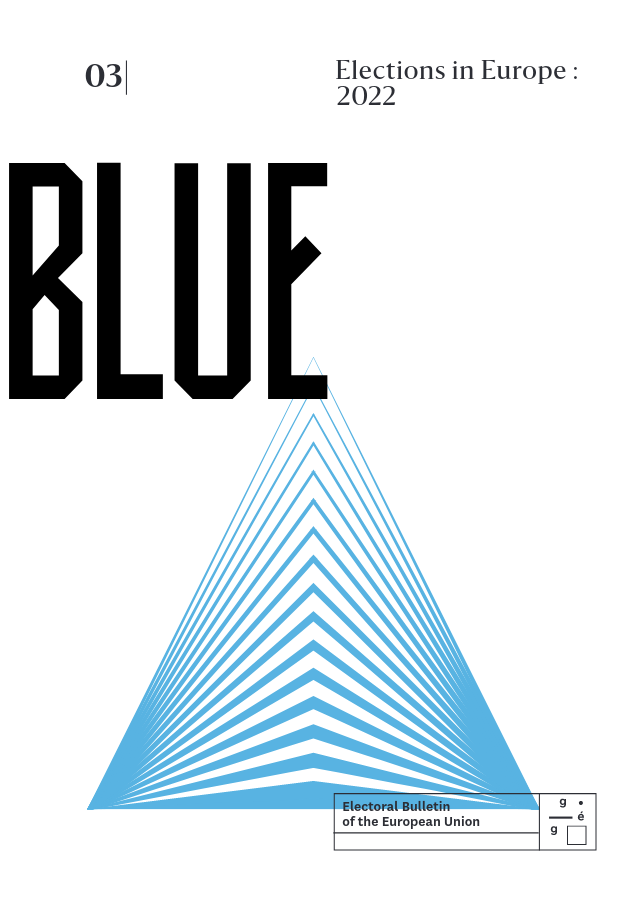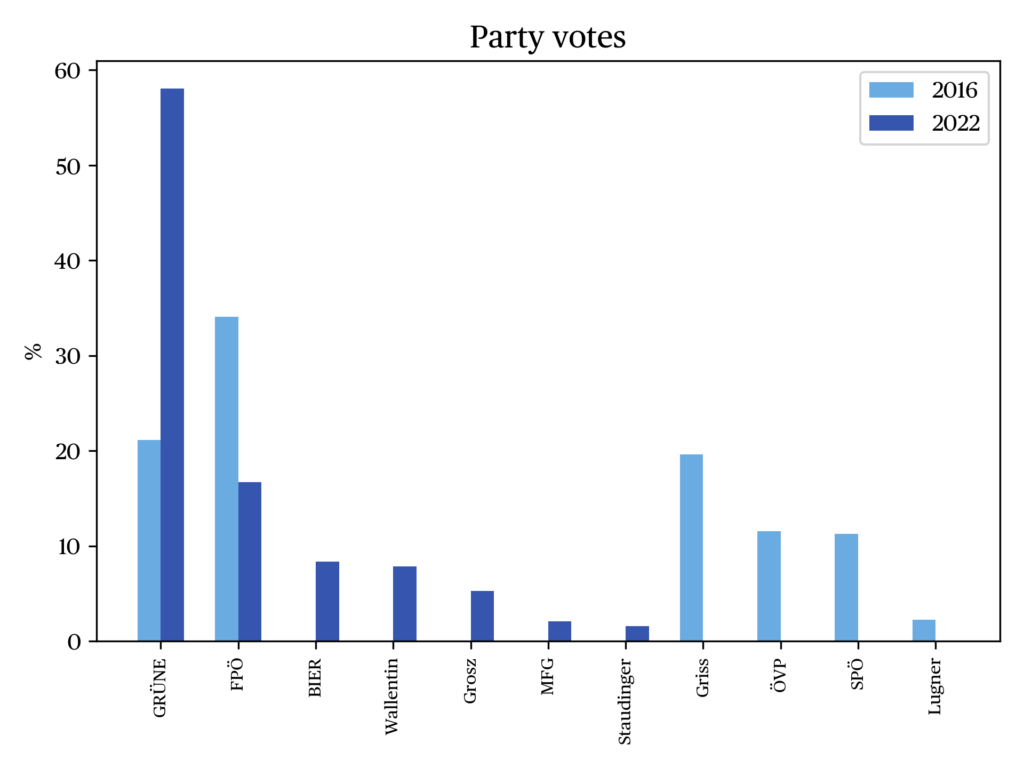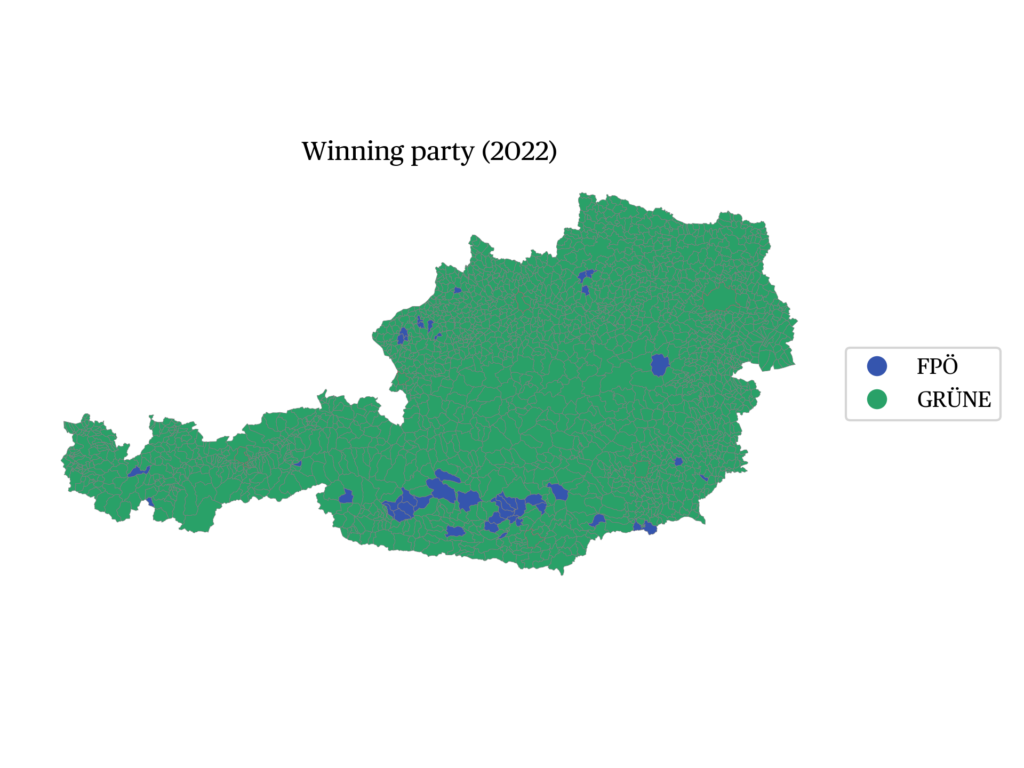Presidential Election in Austria, 9 October 2022
Issue
Issue #3Auteurs
Christina Walcherberger , Julia Partheymüller , Sylvia Kritzinger
Issue 3, March 2023
Elections in Europe: 2022
Introduction
On October 9, 2022, Alexander Van der Bellen was re-elected as Austrian President, starting his second and last term in office. In the following, we describe the institutional role of the Austrian President, some historical aspects as well as the 2016 and 2022 elections which are closely connected.
Institutional role of the Austrian President
Austria can be classified as a semi-presidential system as “[…] All acts of the Federal President, unless otherwise provided by the Constitution, [must] be done on the proposal of the Federal Government or the Federal Minister authorised by it [… and] require […] the countersignature of the Federal Chancellor or the competent Federal Ministers” (Müller 2006). Following the definition presented by Elgie et al. (2011), semi-presidentialism is defined as a political system in which a country’s constitution makes provision for both a directly elected president as the head of state and a prime minister and cabinet that are collectively responsible to the legislature. Since this definition makes no reference to the powers of the president as a defining feature of the concept, it makes the identification of semi-presidential countries relatively straightforward because no judgment needs to be made as to whether a president is sufficiently powerful for a country to be classed as semi-presidential (Elgie 2011).
In the Austrian case, the president has de facto very limited decision making power, while being de jure endowed with manifold rights and obligations. The most important tasks of the Austrian President are the appointment and dissolution of the government, the dissolution of the National Council and the external representation of the Republic. In addition, the President is commander-in-chief of the armed forces, is responsible for the certification of the constitutional coming into being of the federal laws, has the right of emergency decree and pardon and “represents the Republic as a whole” (Müller 2006). By means of these activities, it is also possible for the President to set the political tone or to signal approval or disapproval. While since 1929 the Federal Presidency in Austria can be considered a strong political institution, it nevertheless plays only a relatively passive role in day-to-day politics, as it requires a proposal from the government to take action. The reasons for this “weak” presidential component are (1) the historical character of the office with a rather reserved understanding of office, (2) the relatively strong role of the political parties in Austria and (3) the lack of bureaucratic resources to exert great influence. Thus, Austrian presidents so far saw themselves, and acted, as an authority in reserve (Müller 2006).
Austrian presidential elections since 1949
Only since 1951 has the Austrian president been elected by popular vote. Austrian Presidents are elected for a six-year term. Acting as President is limited to two consecutive terms of office. The electoral rule foresees a two-round electoral procedure: a candidate is elected President if s/he obtains 50 per cent plus one vote; if no candidate obtains this result in the first round, a second round follows with only the two top-candidates of the first round allowed to run. A 50% plus one vote result is thus guaranteed.
Former Austrian Presidents have usually been older — the median age at the first election is 66 years — and so far have been exclusively male. Candidates for office were often not top representatives of a party, but almost all of them had previously held “genuinely political positions” such as being the president of the National Council, former ministers, etc. (Müller 2006). Above all, the presidential election can be labeled a personality election.
From 1945 to 1974, all Austrian presidents came from the Social Democratic Party (SPÖ) (Karl Renner, Theodor Körner, Adolf Schärf and Franz Jonas). Rudolf Kirchschläger, who was not officially affiliated with any party, but was nominated by the SPÖ, was President from 1974 to 1986, while from 1986-1992 Kurt Waldheim — nominated by the Austrian People’s Party (ÖVP) but also with no party affiliation — was in office. Waldheim’s candidacy for president was extremely controversial since during the election campaign it was revelead that he had been a member of the SA during the Nazi Regime and had been involved in a war mission in the Balkans during WWII. During his presidency, he therefore remained relatively isolated in foreign policy. He was succeeded, from 1992 to 2004, by a candidate of the ÖVP, Thomas Klestil, who was himself succeeded by the SPÖ politician Heinz Fischer (from 2004 to 2016).
In 2016, for the first time in the Austrian Second Republic, the presidential election was won by a candidate not nominated by the mainstream parties SPÖ or ÖVP: Alexander Van der Bellen was a long-time Green politician who had even been leading the Green party for many years. Alexander Van der Bellen officially ran as an independent candidate but was strongly supported by the Green Party. He became president after a long-lasting electoral campaign which featured many first-time events in Austrian political history.
In the 2016 presidential election, six candidates ran for presidency. In the first round, the SPÖ and the ÖVP candidates only received 11.28 and 11.12 per cent of the votes respectively. The independent candidate Irmgard Griss, supported by the NEOS party and the former president of the Supreme Court, came in third with almost 19 per cent of the votes. The later president Van der Bellen received 21.34 per cent of the votes in the first election round, while Norbert Hofer, who was running for the populist radical-right Austrian Freedom Party (FPÖ), received 35.05 per cent – meaning that these two candidates, located at very different ideological positions on the political spectrum, went into the run-off. After counting the votes in the run-off on May 22, 2016, Van der Bellen was proclaimed winner with a very narrow margin: He obtained 50.35 per cent of the votes, Hofer 49.65 per cent (see panel “the data”).

However, the FPÖ challenged the election result arguing that votes had been counted improperly. The proceedings before the Constitutional Court revealed that the constitutional principle of secret ballots and the provisions of the Federal Presidential Election Act had been violated in 14 Austrian constituencies during the counting of the postal ballots. Approximately 77.000 votes were affected by the non-constitutional counting procedures, while the difference in votes between the two candidates amounted to only approximately 30.000 votes. Therefore, the election result of the second round was annulled by the Constitutional Court on July 1, 2016: the run-off of the presidential election had to be repeated (Parlament 2022). The re-run was held on December 4, 2016 for which the electoral register was updated, adding more than 42.000 newly eligible voters. In the run-off against the candidate of the populist radical right, Alexander Van der Bellen was able to gain the support not only of the center-left parties but also of the center-right, and won the second run-off with 53.8 per cent of the votes. The importance of this particular presidential election was reflected in the voter turnout: 74.2 per cent of eligible voters participated in the election re-run of the second round as compared to 68.5 per cent in the first round and 72.2 per cent in the first second round in May.
The run-up to the 2022 presidential election
The run-up to the 2022 presidential election was marked by special circumstances and several novelties. With seven candidates, there were more candidates than ever before, but, for the first time since 1980, there was no woman running for office. The large number of candidates was also unusual, as the mainstream parties ÖVP and SPÖ did not nominate any candidate, but, as in 2016, supported the incumbent Van der Bellen together with the Green party. The liberal NEOS did not nominate or support any candidate. Van der Bellen kept a relatively low profile in the election campaign and announced only at a late stage that he would be running for president again.The only parliamentary party that nominated its own candidate was the FPÖ. It entered the electoral race with Walter Rosenkranz, a long-standing FPÖ party member.
All other candidates were either members of very small fringe parties not represented in the parliament or were running as independent “personalities”. Dominik Wlazny (also known as Marco Pogo) was the candidate of the Beer Party, which he had founded in 2015 as a satirical party. The Beer Party had limited its activities to the City of Vienna so far, where it won several seats in eleven district councils in the 2020 regional and municipal elections. Michael Brunner, member of the newly founded anti-vax party “Menschen — Freiheit — Grundrechte” (MFG — People, Freedom, Basic Rights) also presented himself as a candidate for presidency. During the electoral campaign, Brunner, a lawyer, attracted attention mainly with his anti-vaccine and science-denying statements.
The other three candidates ran as independent candidates: (a) Tassilo Wallentin, a conservative columnist at Austria’s largest tabloid “Kronenzeitung”; (b) Gerald Grosz, a former politician of the FPÖ and the ‘Bündnis Zukunft Österreich’ (BZÖ — a party founded by Jörg Haider in 2005 that no longer exists) who now was active as a blogger, known for his TikTok videos and the fact that he was Austria’s first openly homosexual presidential candidate; and (c) Heinrich Staudinger, an entrepreneur and shoe manufacturer who had become known to a wider public because of his dispute over crowdfunding with the Austrian Financial Market Authority. During the election campaign, he attracted some attention with questionable statements, amongst others, suggesting that the CIA was behind the MeToo movement.
While the number of candidates running for presidency was very large, there was not much public interest in the election. Public attention largely focussed on the incumbent Van der Bellen and to a lesser extent on the FPÖ candidate Rosenkranz with the other candidates being rather underrepresented – most likely due to the fact that they had no large party supporting them. With regards to the content of the campaign, the usual claims arose, one of them calling for a more “active” president particularly vis-a-vis the government. As mentioned before the Austrian constitution would allow for a more active role but incumbents so far have not used these possibilities. Apart from this, the incumbent Van der Bellen was criticized, particularly by his rivals, for not appearing in TV debates with the other candidates. However, it is common practice in Austria that incumbent presidents do not participate in TV debates.
The results of the 2022 election
After a rather short and uneventful election campaign, the election was held on October 9, 2016. The incumbent Alexander Van der Bellen was able to defend his office with 56.7 per cent of the votes in the first round. Walter Rosenkranz (FPÖ) came in second place at a distance with 17.7 per cent. Tassilo Wallentin and Dominik Wlazny both achieved just over 8 per cent. While former politician Gerald Grosz managed to get 5.6 per cent, Michael Brunner of the MFG party and Heinrich Staudinger only received 2.1 and 1.6 per cent, respectively. The turnout was 65.2 per cent — a noticeable decrease since the last presidential election — reflecting the fact that the 2022 presidential election did not have the same partisan dynamic as in 2016.
While the 2022 results speak clearly in favor of Van der Bellen, some regional peculiarities need to be pointed out. Particularly, in some constituencies in Carinthia – in the south of Austria — the FPÖ candidate Rosenkranz outperformed the incumbent Van der Bellen (see the map in the panel “the data”). This, however, does not indicate that Van der Bellen’s electoral success was ever endangered but rather that some ideological polarization can be observed across the country.
Comparing the 2022 results with the outcomes of the first round in 2016 (right hand map of Austria), it may seem as if the political landscape has changed quite substantially. The main reason for this, however, is that the mainstream parties had united and supported the incumbent in 2022, whereas they had their own competing candidates in 2016, so that the vote split across several candidates, to the advantage of Nobert Hofer.
Consequences of the election
The 2022 presidential election was certainly less dramatic than the 2016 one. Apart from the different nature of the candidates and the lower importance of partisanship, the electoral campaign was uneventful and not very exciting. This may seem surprising due to the far-reaching de jure powers of the head of state. Presidents, however, have never used much of their powers so far; rather, the Austrian President has remained mainly a symbolic figurehead. In the end, the 2022 election was “business as usual”, as most of the Austrian Presidents in the Second Republic have been re-elected for a second term. Whether a more active role of the president is desirable would necessitate a more intensive discussion than the one during the 2022 campaign. Maybe there will be time for that before the next presidential election in 2028.



References
Müller, W. C. (2006). Der Bundespräsident. in Dachs, H., Gerlich, P., Gottweis, H., Kramer, H., Lauber. V, Müller. W. C., & Tálos, E. (eds.), Politik in Österreich: Das Handbuch. Vienna: Manz, 188-200.
Elgie, R. (2011). Semi-Presidentialism in Western Europe. In Elgie, R., Moestrup, S., & Yu-Shan, W. (eds.), Semi-Presidentialism and Democracy. London: Palgrave MacMillan, 81-97.
Republik Österreich Parlament (2022). Bundespräsidentenwahl 2016: Haftung des Wahlleiters für die Kosten einer Wahlwiederholung II. Retrieved 5.12.2022.
citer l'article
Christina Walcherberger, Julia Partheymüller, Sylvia Kritzinger, Presidential Election in Austria, 9 October 2022, Mar 2023, 131-134.
à lire dans cette issue
voir toute la revue





